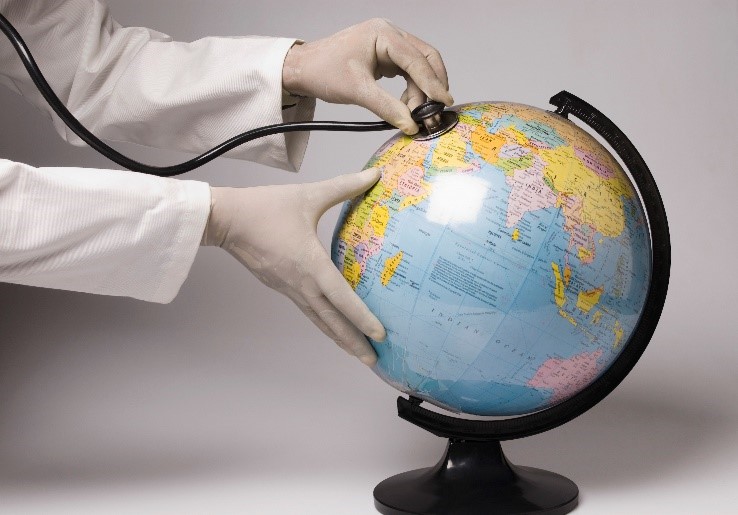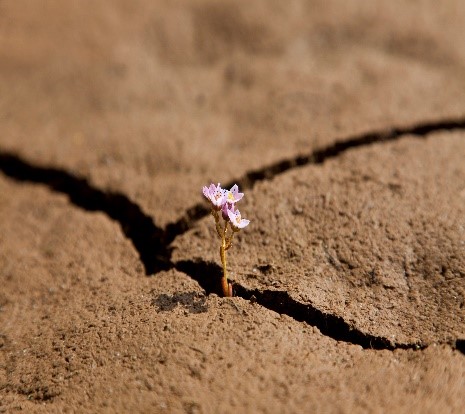 The pandemic brought on by the novel Coronavirus disease seems to be an indication that in order to boost our resilience, humanity must ensure that the planet is in optimal condition and that now, more than ever, is the time to act. We must not only understand the underlying reasons for and impact of the pandemic but will also need to learn from other crises and challenges and the solutions adopted. Lessons learned from climate change response actions, innovative approaches and bioeconomy advancements in the region, provide some inspiring clues to guide us in exploring future actions.
The pandemic brought on by the novel Coronavirus disease seems to be an indication that in order to boost our resilience, humanity must ensure that the planet is in optimal condition and that now, more than ever, is the time to act. We must not only understand the underlying reasons for and impact of the pandemic but will also need to learn from other crises and challenges and the solutions adopted. Lessons learned from climate change response actions, innovative approaches and bioeconomy advancements in the region, provide some inspiring clues to guide us in exploring future actions.
On the other hand, various actors in agricultural production are taking matters into their own hands and are emerging as indispensable for the implementation of solutions. This was made clear in a conversation about COVID-19, organized on 28 April 2020 by the Argentine No-Till Farmers Association – AAPRESID. AAPRESID is a network of producers who, mindful of the importance of preserving their main resource, the soil, have adopted and fostered the dissemination of a new agricultural paradigm based on no-tilling.
|
“Lessons learned from climate change response actions, innovative approaches and bioeconomy advancements in the region, provide some inspiring clues to guide us in exploring future actions” |
“Prevention is better than cure”
The relationship between the COVID-19 crisis and climate change provides us with many lessons, including:
- The importance of assertive and early responses: proactive measures will enable greater mitigation of negative effects and repercussions, as we try to flatten the curve, at a lower social and economic cost.
- The importance of coordination and collective action: coordinated responses at the global, regional, national and sub-national levels that are based on a great degree of mutual trust among actors, while focusing on protection of the most vulnerable, will lead to decisions that impact our most immediate environments. All individuals are called on to act responsibly to contribute to and strengthen collective actions.
- Science-based decision-making: information that will equip us to act, even in a climate of great uncertainty, is readily available. Therefore, it is necessary a strong commitment to generating information that is not only correct, but timely.
Climate change is exacerbating the impact of pandemics such as Coronavirus and vice-versa (co-morbidity). Two aspects, in particular, bear mentioning:
- The impact on climate change: To date, actions and commitments have not been sufficient to resolve this problem. Even with the combined effects of the current commitments of each country under the Paris Agreement, temperatures will rise by 3 ºC, which is below the desired target of 1.5 ºC that would enable us to avoid more catastrophic effects (see Climate Action Tracker). Forecasts indicate that emissions will fall by between 3 to 5% during this year. However, given that this will be due to the slowdown in the global economy, triggered by the current situation, rather than a reflection of structural changes in our socioeconomic system, the contribution to resolving the problem has little significance. In fact, in previous crises, such as the 2008 financial crisis, reduced economic activity caused emissions to drop, but the subsequent economic recovery drove emissions to higher levels than before the crisis. (Peters et al, 2011).
- Impact on willingness to tackle climate change: Given the focus on socioeconomic reactivation throughout the world, where will climate change fall on the agenda? The year 2020 continues to be a critical year for negotiations under the United Nations Framework Convention on Climate Change. Each country will have to submit a more ambitious version of its climate action plan (nationally determined contributions), spurred by the massive social movement that has emerged in recent years. There will be a groundswell of momentum in favor of substantial changes… It remains to be seen, how much of that will continue after this crisis.
|
“In previous crises, such as the 2008 financial crisis, reduced economic activity caused emissions to drop, but the subsequent economic recovery drove emissions to higher levels than before the crisis.” |
Globally, 5 trillion dollars has been earmarked for economic recovery from the impact of COVID-19 (Wall Street Journal). How are we going to invest these funds, ensuring that the agriculture sector invests to increase resilience, lower emissions, and thereby boost the future efficiency and competitiveness of agrifood production? What environmental and social safeguards will we put in place? What limitations will we place on this investment in order to create the low-carbon and more climate-resilient societies and economies that we desire?
The agrifood sectors has a particularly important role to play in responding to these questions. We will need to capitalize on this situation—which is still at a critical stage—to enhance efficiency, sustainability, resilience and competitiveness. It will call for a commitment by different public and private actors; renewed emphasis on more robust innovation systems, and the application of more holistic and integrated alternatives, such as those offered by the bioeconomy model.
“When the winds of change blow (…) ‘some’ build windmills”
The aforementioned need to improve the efficiency, sustainability, resilience and competitiveness of the agrifood sector to respond to climate change, will require us to reinvent and change the way that we operate, both in the field and throughout the entire production chain. The introduction of these changes, which will be critical to achieving a green recovery post-COVID-19, is what we know as innovation. The pandemic, like other crises, is a trigger for innovation processes, much in the same way as other factors that are usually thought to be drivers for agricultural innovation (IICA 2019, French et al. 2014), such as new technologies, market changes, pressure on natural resources or social changes. The crisis has highlighted the need for change and has spurred innovation. Therefore, the pandemic and the severe ensuing impact on the entire socio-productive structure, can be capitalized on as a means of fueling the imagination and the introduction of profound changes in the sector.
|
“The pandemic has brought to the fore the importance of science and technology in tackling crises, but we must now advocate for this recognition to translate into greater support for agricultural science and technology.” |
Activation of innovation processes will necessitate a series of both technical and financial capacities. Particularly important will be soft skills, such as context knowledge and the capacity to collectively build a vision for the future, as well as the roadmap to achieve it. The pandemic has brought to the fore the importance of science and technology in tackling crises, but we must now advocate for this recognition to translate into greater support for agricultural science and technology. Moreover, innovation will require an enabling environment, that is, policies, institutions, educational systems and other factors that will facilitate innovation. Taking advantage of these opportunities and activating innovative change processes for a new, more resilient, productive and inclusive agriculture sector may therefore entail the following:
to collectively build a vision for the future, as well as the roadmap to achieve it. The pandemic has brought to the fore the importance of science and technology in tackling crises, but we must now advocate for this recognition to translate into greater support for agricultural science and technology. Moreover, innovation will require an enabling environment, that is, policies, institutions, educational systems and other factors that will facilitate innovation. Taking advantage of these opportunities and activating innovative change processes for a new, more resilient, productive and inclusive agriculture sector may therefore entail the following:
- An in-depth knowledge of the context.
- A prospective and collective vision of where we want to go.
- Development of the mechanisms to be able to collectively build a future.
- The designing of all elements of the agrifood system, with a view to the future.
- Promotion of development and strengthening of public policies that reinforce the use of science and technology in the sector and enable innovation that is inclusive in every sense.
“The environment itself is not enough; it must be intact”
What are the connecting factors between climate change, innovation and bioeconomy? COVID-19 has once again reminded us of a great lesson: human and environmental health are intricately linked. Renewing our commitment to adapt measures and practices in response to climate change continues to be a priority for the agrifood sector. Technological, as well as process and production innovations will be imperative, in order to establish the bioeconomy, based on creative, flexible production systems with the capacity for transformation to enable responsible socioeconomic reactivation.
|
“The bioeconomy concept redefines relationships not only between inputs and products, but also between public-private actors in territories and production systems” |
The bioeconomy contributes elements that allow us to take a more in-depth look at emerging opportunities to recover from the impact of COVID-19 and of climate change, without further endangering sustainability for future generations. The concept of the bioeconomy redefines relationships, not only between inputs and products, but also between public-private actors in territories and production systems. It involves the use of resources, processes, technologies and biological expertise in developing products and services (IICA, FAO, ECLAC 2019). Transformation and innovation are inherent to the creativity and flexibility needed to implement and capitalize on the bioeconomy in various value chains. The bioeconomy proposes new solutions that help to mitigate the effects of climate change, by substituting petrochemical products with materials that result in lower greenhouse gas emissions (GHG), even while developing new businesses and technologies that foster a sustainable economy, promote circularity in production processes (Carus, 2017) and minimize the generation of waste.
|
“Undoubtedly, the time to tackle climate change is now. The trends are clear-cut, even amidst the uncertainty.” |
“(…) if you want to go far, go together”
Undoubtedly, the time to tackle climate change is now. The trends are clear-cut, even amidst uncertainty. Who is doing what? How is international cooperation coordinating the post-COVID-19 socioeconomic recovery to provide solutions rather than to exacerbate the climate problem? There are no set formulas. Day by day we must explore combinations and alternatives to resolve these problems. There is a pressing need for adaptation and contextualization to solidly support actions. Having analyzed the crisis and possible solutions, a panel of 27 experts from IPES-Food has stressed the need to transform food systems to develop resilience at all levels (CIRAD, 2020). The business as usual attitude appears to be losing ground, as we have now been given this chance to seize this opportunity to venture out of our comfort zones.
|
The pandemic is reminding us that agricultural producers are part of the solution and that their daily toil will be instrumental in overcoming these times of crisis. |
Certain truths are being reaffirmed. If we want to go far, we will have to do it together, in an organized manner, relying on public and private sector  collaboration, ever mindful of the path and lessons of previous crises, while envisioning what remains to be done and how much work is still needed. We cannot afford to waste time. The agrifood sector has a pivotal role to play. The pandemic has come about to remind us that agrifood producers are part of the solution and that their daily toil will be instrumental in overcoming these times of crisis. Providing healthy food to improve economies, environments and standards of living in an inclusive and sustainable manner is the responsibility of the multiple actors that make up the agriculture sector.
collaboration, ever mindful of the path and lessons of previous crises, while envisioning what remains to be done and how much work is still needed. We cannot afford to waste time. The agrifood sector has a pivotal role to play. The pandemic has come about to remind us that agrifood producers are part of the solution and that their daily toil will be instrumental in overcoming these times of crisis. Providing healthy food to improve economies, environments and standards of living in an inclusive and sustainable manner is the responsibility of the multiple actors that make up the agriculture sector.
You may access the complete webinar at this link
Maria Beatriz “Pilu” Giraudo is an Agronomist. She is currently an Advisor to IICA’s Climate Change, Natural Resources and Management of Production Risks program and the Honorary President of AAPRESID.
Kelly Witkowski is a graduate of American University and the University for Peace (Costa Rica), from which she earned Master’s degrees in Natural Resources and in International Relations, respectively. She is currently the Manager of IICA’s Climate Change, Natural Resources and Management of Production Risks program.
Viviana Palmieri is an Agronomist, with a Master’s in Crop Production Systems from the Tropical Agricultural Research and Higher Education Center (CATIE). She is currently a Technical Specialist in Agricultural Innovation and Technology and the Coordinator of IICA’s cross-cutting area of focus on Innovation and Technology.
Gabriela Quiroga holds a MSc. in International Development Studies from the University of Amsterdam, with a Licenciate in Social Sciences from the Catholic University of Uruguay. She is currently a Technical Specialist in Family Farming Innovation and a member of IICA’s Bioeconomy and Production Development Program.
Note: The opinions expressed in this article are the responsibility of the authors and do not necessarily reflect the opinion of IICA.
Blog comments
El cable a tierra
Excelente articulo colegas!
Me gusta la frase que citan "Hay una necesidad acuciante de adaptación y de contextualización para apoyar acciones con cable a tierra." El cable a tierra son las organizaciones de productores, las ONG que trabajan comprometidas en campo, los profesionales de los proyectos de desarrollo, los proveedores de insumos honestos. Con estos hay que trabajar para promover innovación que ayude a manejar pandemias, contribuya a nuevos modelos productivos y de asociatividad, mejore la adaptación al cambio climático y contribuya a la mitigación.
Solo teniendo el cable a tierra se puede hacer la diferencia. Estamos de acuerdo.
Add new comment